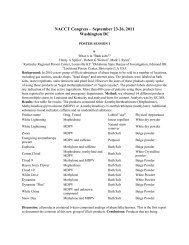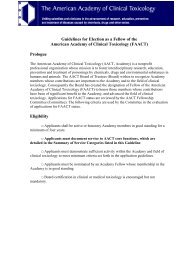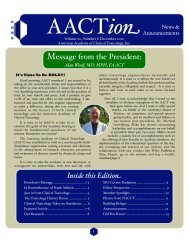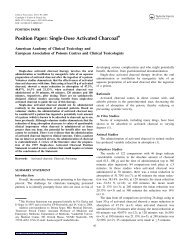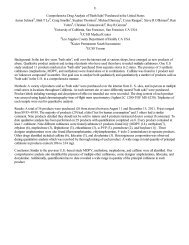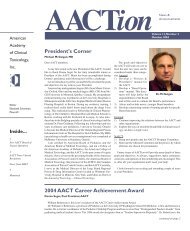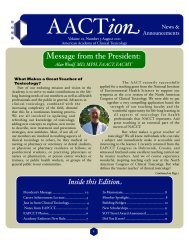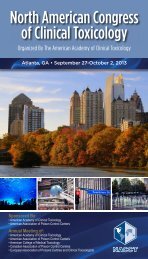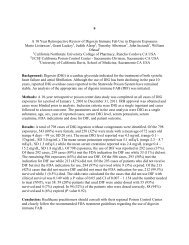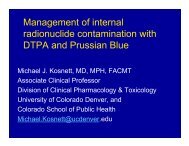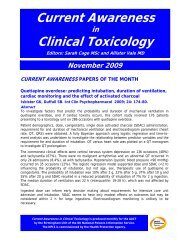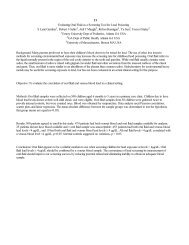Posters IV - The American Academy of Clinical Toxicology
Posters IV - The American Academy of Clinical Toxicology
Posters IV - The American Academy of Clinical Toxicology
You also want an ePaper? Increase the reach of your titles
YUMPU automatically turns print PDFs into web optimized ePapers that Google loves.
1 Fletcher Allen Health Care, Burlington VT 2 Salus Consulting, LLC, Minneapolis MN USA<br />
3 Northern New England Poison Center, Portland ME USA<br />
Background: It can be difficult for refugees who are not native English speakers to understand the poison<br />
center's role and when to call. Lack <strong>of</strong> awareness and language or cultural barriers may contribute to<br />
underutilization <strong>of</strong> poison center services. It is important to develop materials and provide education to<br />
overcome these barriers. Methods: Three refugee groups (Bhutanese, Burmese and Swahili- or Kirundispeaking<br />
central Africans) in a rural state were educated about poison center services and poison<br />
prevention in 2010. <strong>The</strong> groups represented both newly resettled and established refugee populations. This<br />
IRB-approved project involved two sessions, one week apart. <strong>The</strong> trainings were promoted by a nonpr<strong>of</strong>it<br />
resettlement agency and consisted <strong>of</strong> interpreted pre- and post-surveys, a pre-recorded PowerPoint<br />
presentation and review <strong>of</strong> key prevention behaviors. Graphic-based magnets and translated postcards<br />
were distributed. A follow-up survey was administered one week later to assess knowledge retention and<br />
behavioral changes. All de-identified data were analyzed for statistical significance (at p≤.05) using T-<br />
Tests with SPSS s<strong>of</strong>tware. As an incentive for completing the one-week follow-up survey, a water bottle<br />
was given to each participant. Results: Initially there were 64 participants (18 Burmese, 34 Bhutanese and<br />
12 Swahili- or Kirundi-speakers). <strong>The</strong> pre-survey found that only 19% (n=12) had ever heard <strong>of</strong> the<br />
poison center. <strong>The</strong>re was variation between groups. <strong>The</strong> Swahili-speakers, a more settled group, had the<br />
greatest initial awareness (46%) and the Bhutanese the least (3%). Post-survey results showed a<br />
statistically significant improvement in knowledge <strong>of</strong> ways poisons can enter the body and when to call<br />
the poison center versus 911 for a child medication-related poisoning. 73% (n=47) completed the oneweek<br />
follow-up survey. Participants were asked to complete five prevention steps. All <strong>of</strong> these steps were<br />
completed by at least 84% <strong>of</strong> participants and two were completed by 100%. Conclusion: Poison<br />
prevention education to non-English speaking refugees is effective in increasing awareness <strong>of</strong> poison<br />
center services and changing behaviors. Participants' feedback showed strong interest in the topic and<br />
available resources. Several Swahili-speaking participants requested to become future peer educators.<br />
Some limitations include: possibly confusing and poorly designed questions; variation in interpretation<br />
skills, potentially affecting participants' responses; possible sharing <strong>of</strong> answers; small study size;<br />
significantly lower participation percentage for the one week follow-up session; and inability to match<br />
follow-up responses with pre- and post-surveys.<br />
273<br />
MASS CARBON MONOXIDE POISONING IN A SCHOOL: A CALL TO ACTION<br />
Katherine Hart 1 , Amy L Hanoian-Fontana 1 , Lauren M Salinger 1 , Marc J Bayer 1<br />
1 Connecticut Poison Control Center, Farmington CT USA<br />
Background: Our Poison Control Center (PCC) was contacted about a mass carbon monoxide (CO)<br />
exposure in a public elementary school serving grades K - 5. Thirty-two fifth grade students, ages 8 to 11<br />
years old, and 3 adult staff members were treated at two local emergency departments for CO<br />
poisoning. Symptoms in most patients included headache, nausea and dizziness, and<br />
carboxyhemoglobin levels up to 12% were measured after some treatment with 100% oxygen. CO<br />
levels <strong>of</strong> 40 to 125 ppm were measured inside the school. All patients were treated with normobaric 100%<br />
oxygen for 4 - 6 hours; symptoms resolved and all were discharged home. Investigation revealed the<br />
source was a malfunctioning boiler, and also revealed that carbon monoxide detectors were not present in<br />
the school. We discovered that there is no state requirement for carbon monoxide detection / alarm<br />
equipment in schools. CO, a colorless, odorless, potentially deadly gas, is produced during incomplete



